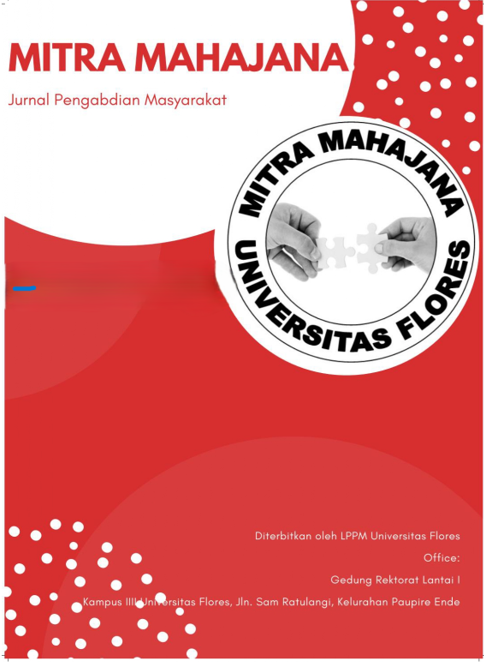Pendampingan Pembelajaran Bahasa Inggris melalui Contextual Teaching and Learning pada Orang Tua Murid
DOI:
https://doi.org/10.37478/mahajana.v3i2.1976Abstract
Giving guidance to young learners needs a specific strategy that fixes to their needs and world. This social service was conducted from May up to June for all parents who jlin in the organization of teachers and parents in SDIT Alif Smart Surakarta. We have three methods in conducting this activity: (1) Need Analysis, which was done by interviewing parents about their way of accompanying their children in learning English at home, and (2) Socialization about contextual teaching and learning in learning English. It was done by giving material explanation about the notion, steps, and implementation of contextual teaching and learning in learning English at home in accordance to their daily life; and (3) Feedback. This was done by giving feedback about the implementation of contextual teaching and learning in daily life English at home. At first, we coordinated the activity. And secondly, there’s a meeting to encourage all members to have motivation besides giving material for them. The material is all about the implementation of contextual teaching and learning in guiding children to learn English at home. In fact, we discussed how to help all children to learn English and deal with their daily life. There are also questions and answers about how to guide children to learn English effectively and how to solve problems in learning English.
Downloads
Keywords:
Contextual Teaching and Learning approach, Learning English, ParentReferences
Ekowati, Ch, K., Muhammad, D., Upa, H. M. D., & Tahmir, S. (2015). The application of contextual approach in learning mathematics to improve students motivation at smpn 1 kupang. International Education Studies, 8(8), 81-86.
Fakhrizal (2017). Strategi Pembelajaran Student Facilitator and Explaining. http://www.jejakpendidikan.com/2017/03/strategi-pembelajaran.html (Diakses 12 Maret 2018)
Glynn, S. M., & Winter, L. K. (2004). Contextual teaching and learning of science in elementary schools. Journal of Elementary Science Education.
Gredler, M. E. B. (1994). Belajar Dan Membelajarkan. Jakarta: PT Raja Grafindo Persada.
Johnson E.B. (2002). Contextual Teaching & Learning, What it is and why it’s here to stay. California: Corwin Press, Inc.
Johnson E.B. (2007) Contextual Teaching & Learning Menjadikan Kegiatan Belajar-Mengajar Mengasyikkan dan Bermakna. Bandung: Mizan Learning Center (MLC).
Komalasari, K. (2014). Pembelajaran Kontekstual. Bandung: PT. Refika Aditama.
Lina Meliniwati R. (2017). Ilustrasi Bahan Ajar di Sekolah Dasar: Kekuatan Gambar dan Pencitraan.https://www.researchgate.net/publication/321684540_
Musyafa, M., Warsali, W., Milah, C. S., Aliyudin, A., Supianti, I. I., & Amam, A. (2020). Pendekatan Contextual Teaching and Learning (CTL) untuk Meningkatkan Pemahaman Matematik Siswa Pada Materi Aritmatika Sosial. Teorema: Teori dan Riset Matematika, 5(1), 69-76.
Setiana, N. (2013). Penerapan Model Pembelajaran Kontekstual Untuk Meningkatkan Hasil Belajar IPS Siswa Kelas IV Sekolah Dasar. EduHumaniora| Jurnal Pendidikan Dasar Kampus Cibiru, 5(1).
Orr, Jannet K. (1999) Growing Up with English. Washington, DC 20547:Office of English Language Programs. United States Department of State.
Richards, Jack C., and Theodore S. Rodgers. (1992.)Approaches and Methods in Language Teaching. A Description and Analysis. Cambridge.
Selvianiresa, D., & Prabawanto, S. (2017). Contextual teaching and learning approach of mathematics in primary schools. Journal of Physics: Conference Series, 895, 012171, 1-7.
Sudjana, N. (2010). Cara Belajar Siswa Aktif. Bandung: Sinar Baru Algensindo.
Downloads
Published
How to Cite
Issue
Section
License
Copyright (c) 2022 Sri Handayani, Riyani Riyani, Fhara Dwika Feby Charista

This work is licensed under a Creative Commons Attribution-ShareAlike 4.0 International License.
The authors and other parties are bound to the Attribution-ShareAlike 4.0 International license (CC BY-SA 4.0 DEED) for the published articles. This permits users to:
Share — copy and redistribute the material in any medium or format for any purpose, even commercially.
Adapt — remix, transform, and build upon the material for any purpose, even commercially.
The licensor cannot revoke these freedoms as long as you follow the license terms.
Under the following terms:
Attribution — You must give appropriate credit , provide a link to the license, and indicate if changes were made . You may do so in any reasonable manner, but not in any way that suggests the licensor endorses you or your use.
ShareAlike — If you remix, transform, or build upon the material, you must distribute your contributions under the same license as the original.
No additional restrictions — You may not apply legal terms or technological measures that legally restrict others from doing anything the license permits.






